SOWK 487 Week 15 - Group Work in Organizational and Community Settings Part II
A presentation at Heritage University @ CBC Week 15 in in Pasco, WA 99301, USA by Jacob Campbell
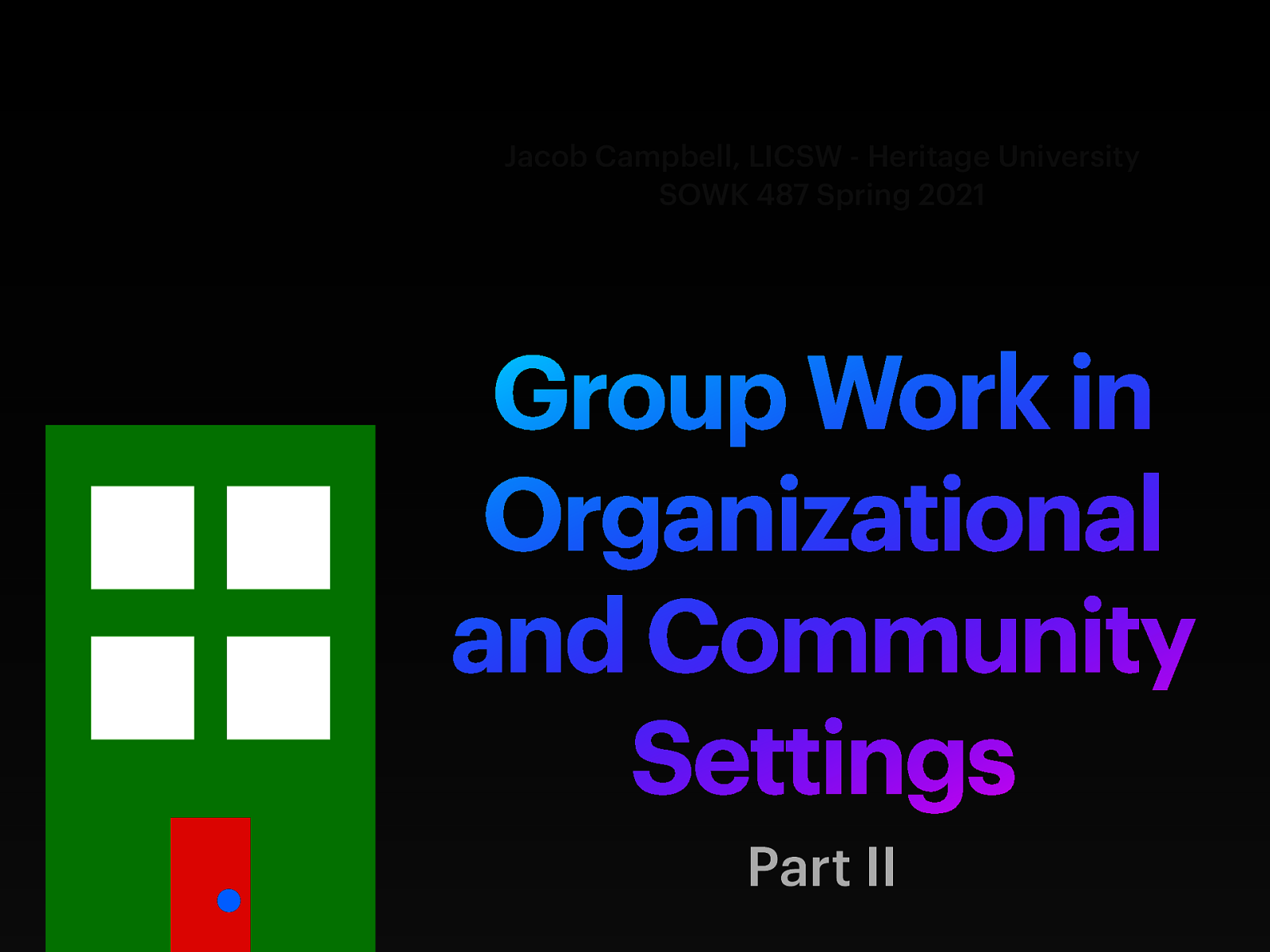
SOWK 487 Spring 2021 Planning: Class 15
Time: Wednesday’s from 5:30-8:15
Date: 04/21/21
Content: Group Work in Organizations and Community Settings II
Reading Assignment: Garvin et al. (2017) Chapters 27 & 28
Due Dates:
- A-01: Synchronous Class Engagement Attend class
- A-02: Asynchronous Class Engagement How do you see yourself as a leader 04/25/21 at 11:55 PM via Flipgrid
- A-04: Research Paper to Inform Group Practice is due Friday 04/23/21 at 11:55 PM via Chalk and Wire Assignment on My Heritage
- Read Garvin et al. (2017) Chapters 27 & 28
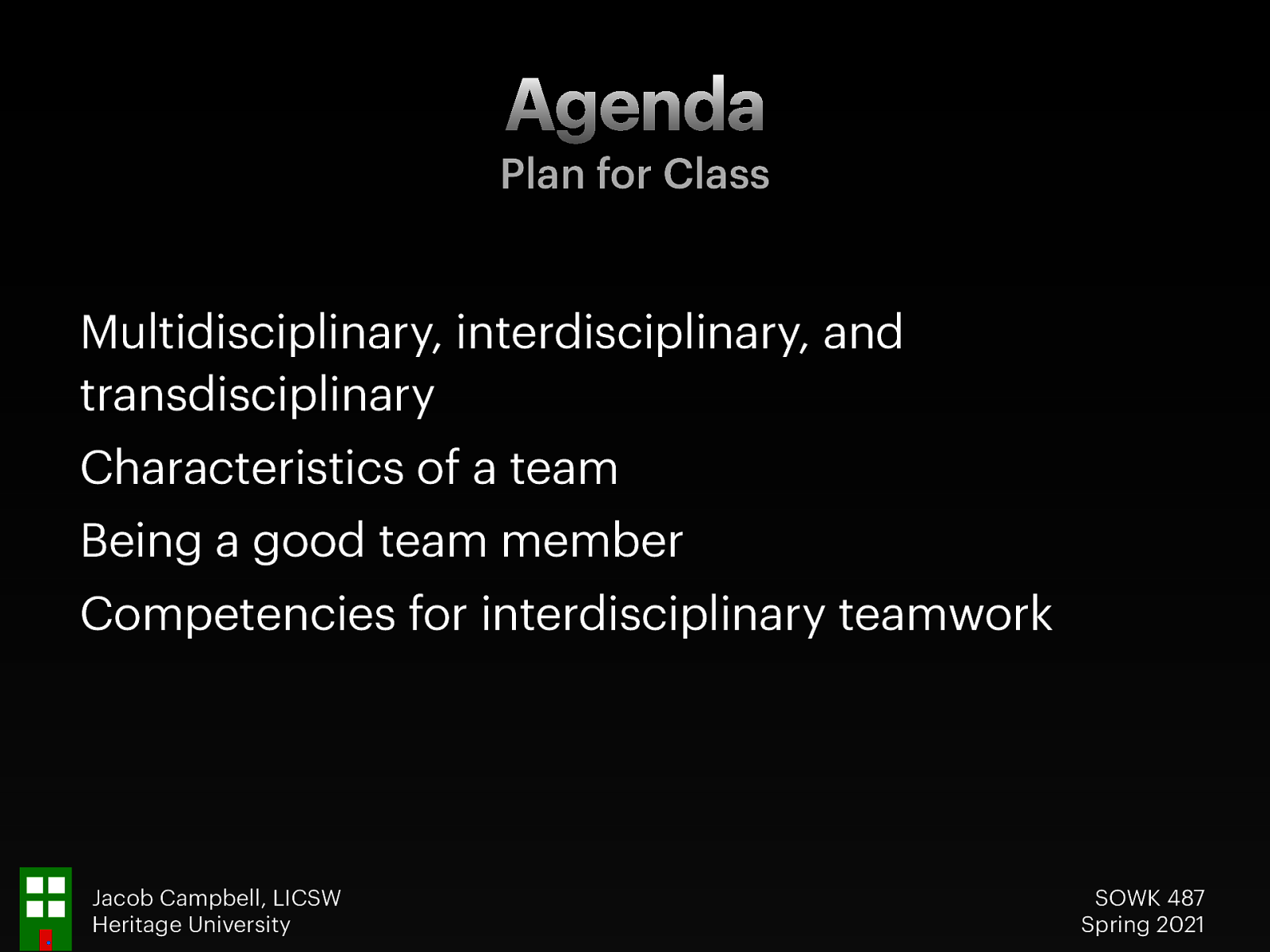
Agenda: Plan for Class
- Multidisciplinary, interdisciplinary, and transdisciplinary
- Characteristics of a team
- Being a good team member
- Competencies for interdisciplinary teamwork
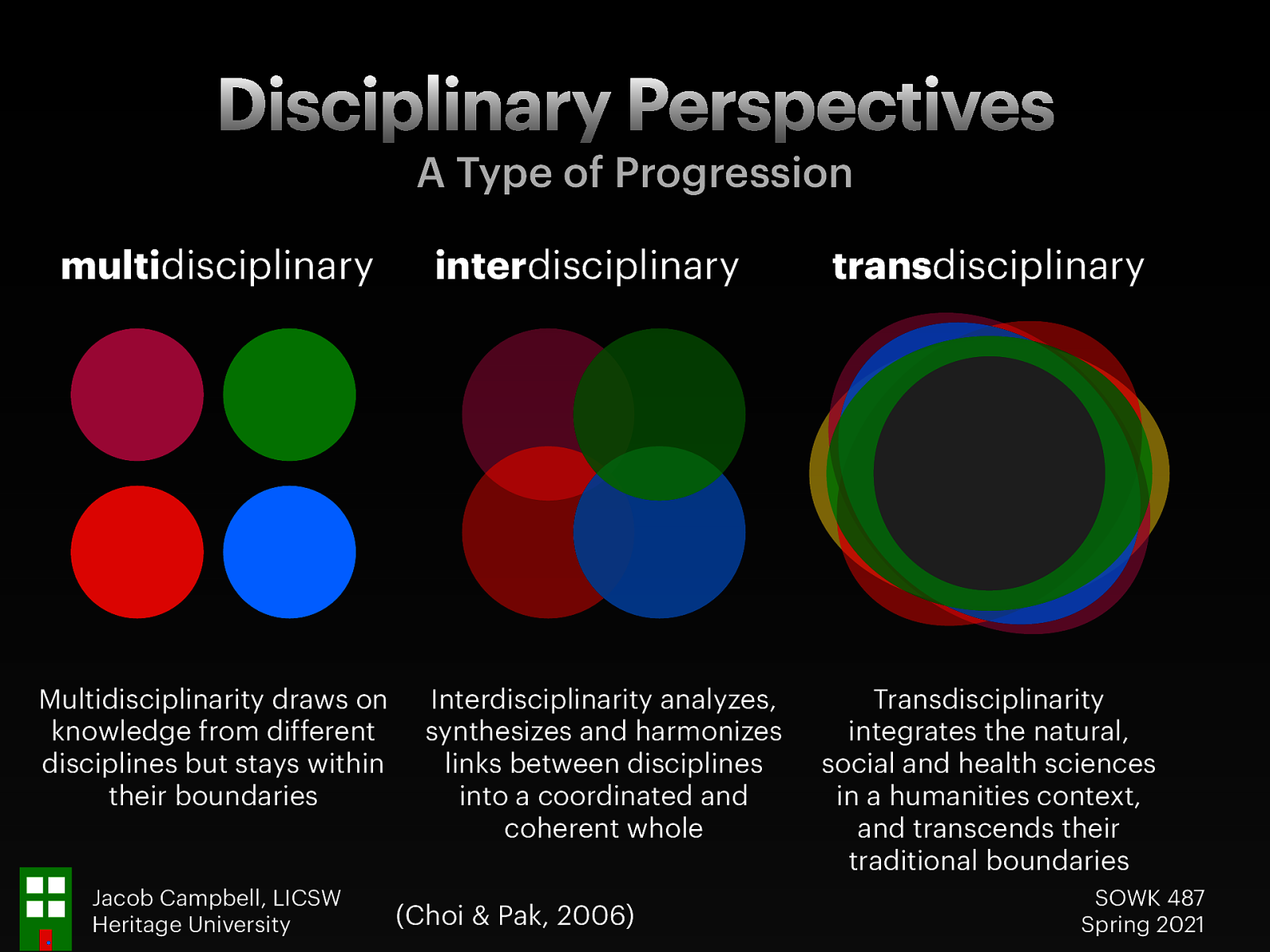
Disciplinary Perspectives: A Type of Progression
Terms you might find in the literature around different integrations of disciplines are as follows: multi, inter, and trans. Transdisciplinary work is a hallmark of the Ph.D. program I am participating in. Choi and Pak (2006) provide some concise definitions to what each of these is:
- Multidisciplinary: Multidisciplinarity draws on knowledge from different disciplines but stays within their boundaries.
- Interdisciplinary: Interdisciplinarity analyzes, synthesizes, and harmonizes links between disciplines into a coordinated and coherent whole.
- Transdisciplinary: Transdisciplinarity integrates the natural, social and health sciences in a humanities context, and transcends their traditional boundaries.
Choi, B. C. K., & Pak, A. W. P. (2006). Multidisciplinarity, interdisciplinarity and transdisciplinarity in health research, services, education and policy: 1. Definitions, objectives, and evidence of effectiveness. Clinical and Investigative Medicine. Medecine Clinique Et Experimentale, 29(6), 351–364.
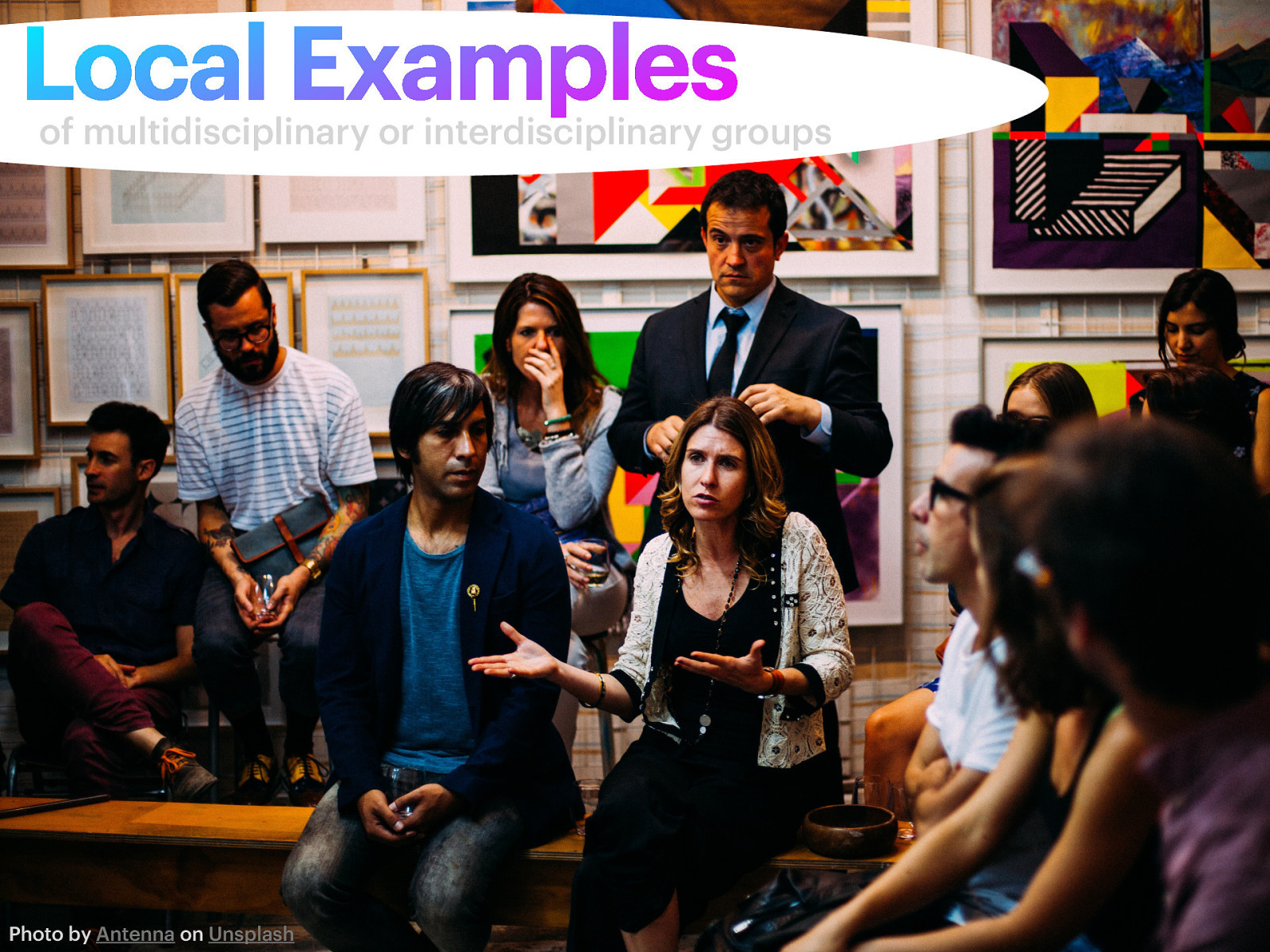
Multidisciplinary or Interdisciplinary Teams
Multidisciplinary (or interdisciplinary) teams can be found in working in child welfare as discussed in the text or in a number of other contexts.
- What are multidisciplinary teams?
- Examples of multidisciplinary teams
- Psychiatric consulting at TCCH BHS
- School IEP meetings
- Wraparound meetings
- Pasco Discovery Coalition
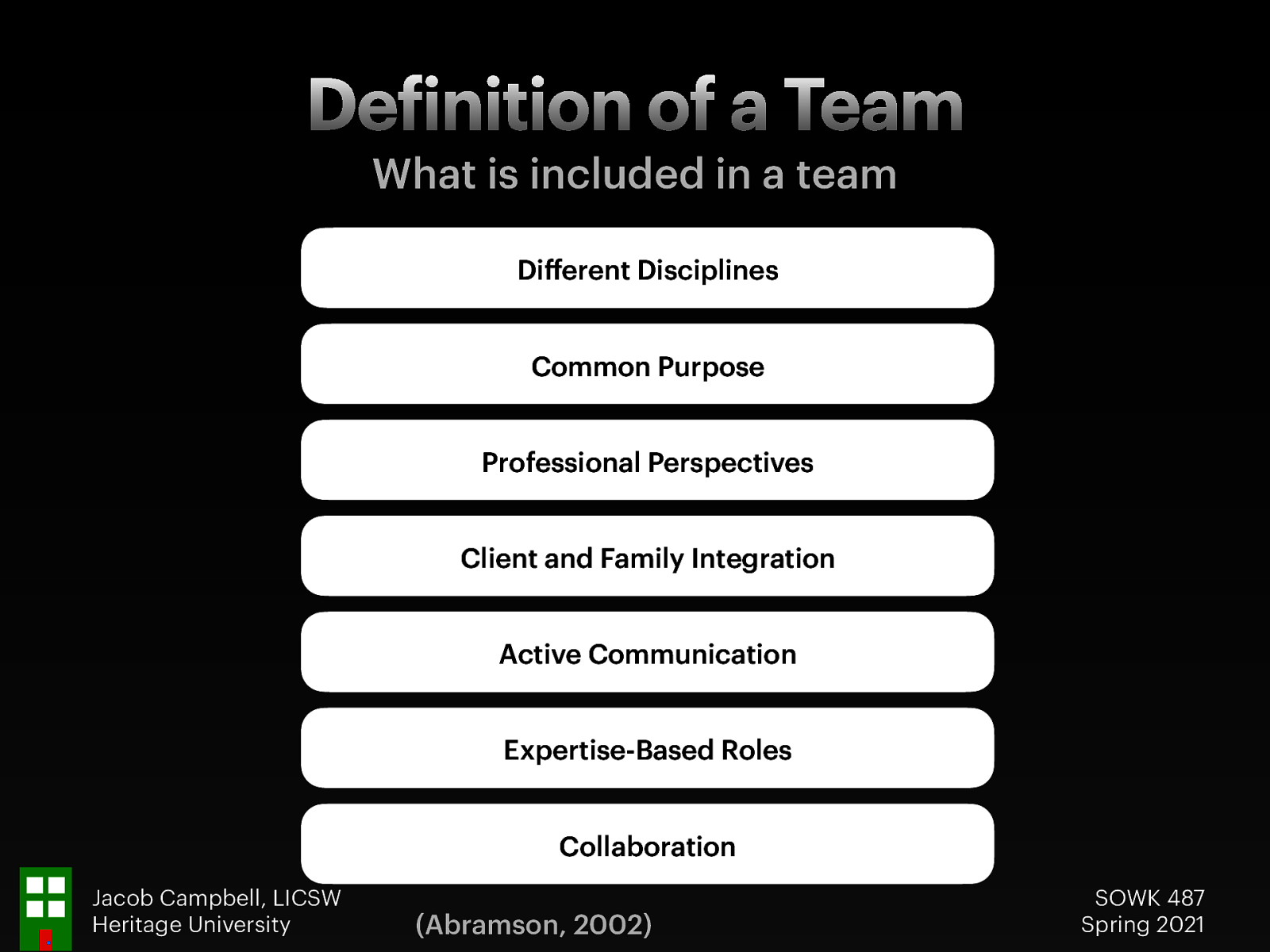
Definition of a Team
Abramson (2002) as cited in Gavin describes that effective interdisciplinary teams incorporate the following aspects:
- Different Disciplines: A group of professionals from different disciplines
- A common purpose
- Professional Perspectives:Integration of various professional perspectives in decision making
- Integration of the client and family into the team decision-making process
- Active communication
- Expertise-Based Roles: Role division based on expertise
- A climate of collaboration
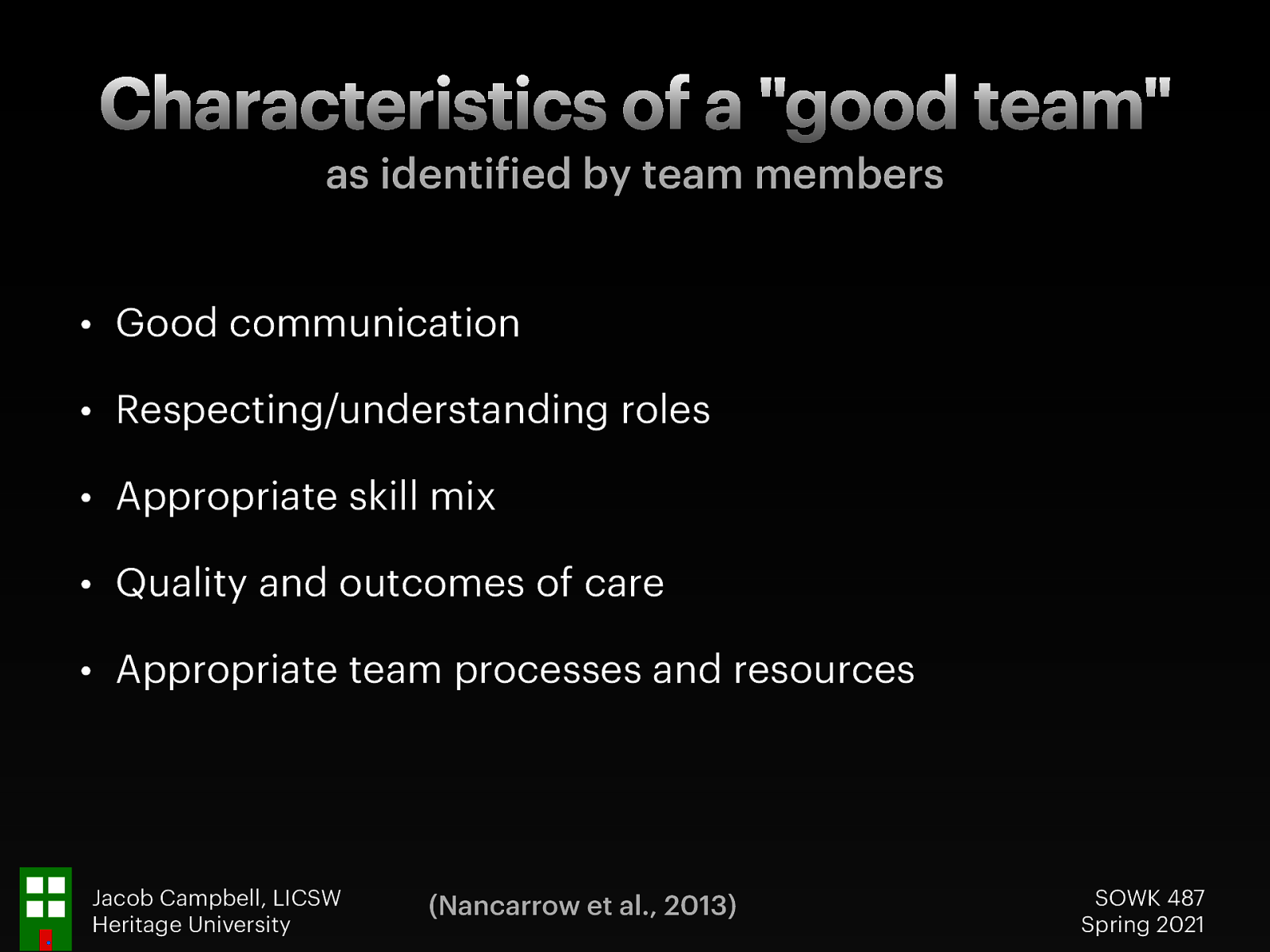
Characteristics of a “good team” as identified by team members (1 of 3)
Nancarrow et al. (2013) go on to report on what are some of the characteristics of what a good team member does.
- Good communication: Communication primarily referred to intra-team communication
- Included team members feeling as though they could listen as well as speak out within a team context; and the ability to discuss and resolve difficulties within the team.
- It was suggested that being part of a large team hinders good communication by limiting the “two-way” communication and that some peoples’ views do not travel “upwards”.
- Respecting/understanding roles:
- Importance of respecting and understanding the roles of other team members; that the limitations and boundaries of each role were well understood; and to have an understanding of how the roles have the potential to impact on patients.
- Practitioners should also be aware of how their own role fits within the team, and differs from that of other team members, and that roles and responsibilities are made explicit.
- Appropriate skill mix: Skill mix refers to the mix and breadth of staff, personalities, individual attributes, professions and experience.
- Teams value diversity, and clearly need input from a range of staff who bring complementary experience and attributes to the team.
- Teams also felt that it was important to have the full complement of staff.
- Quality and outcomes of care: Ensuring the quality and outcomes of care was identified as an important component of a good team and includes several reflective mechanisms both within and external to the team.
- Teams emphasized the importance both to have systems for capturing their effectiveness (such as measuring patient outcomes); and to meet their targets.
- This included suggestions that teams are able to reflect; accept criticism and act on it; have defined outcomes; follow-up patients; provide feedback to other services (for example, on appropriateness of referrals and timeliness and appropriateness of information provided); and celebrate their own successes; and clinicians keeping their skills up to date.
- Appropriate team processes and resources: This theme includes access to sufficient physical resources (office space, parking, computers); privacy to make confidential phone calls; appropriate and efficient systems and procedures, including induction processes, policies, and paperwork that serves the need of the service whilst avoiding duplication.
- Workload management, having enough time to do the job, and time management were highlighted by several teams.
- Finally, the pathway for patients and the integration of the team with wider services was seen as an important procedural issue.
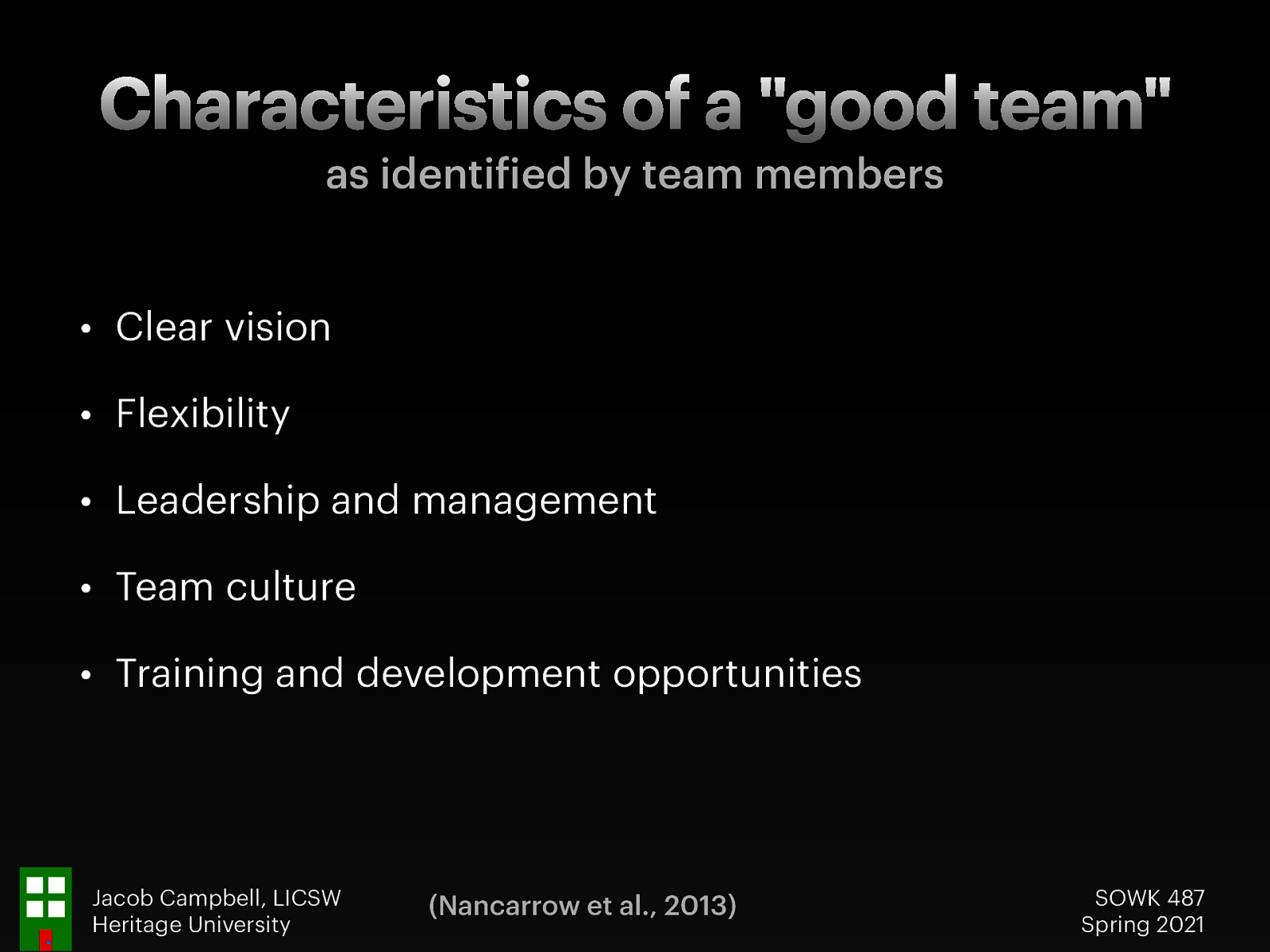
Characteristics of a “good team” as identified by team members (2 of 3)
- Clear vision: Participants identified the need for a clear vision, role, and purpose of the team.
- This was both to steer the direction of the team, but
- also required so that teams could establish appropriate referral criteria into the team.
- Flexibility (of the team and the individuals within it): The need for flexibility was identified as an individual attribute “ability to cover each other’s roles, but knowing your boundaries”.
- Individuals also need to be flexible to respond to the constantly changing service environment and patient needs (for instance, the flexibility of working hours).
- Flexibility of the service was also identified, for instance, flexibility in referral criteria.
- Leadership and management: All teams identified the importance of good leadership, and the characteristics of a good leader are explored elsewhere.
- Team culture: camaraderie and team support/relationships:
- The importance of team culture was the largest theme, with 66 items within this theme.
- Trust, mutual respect, reliability, commitment, and support were the most commonly raised themes.
- But team culture included the importance of informal relationships, camaraderie, fun, and friendship between colleagues.
- Training and development opportunities: Opportunities for gaining new knowledge, sharing knowledge, continuing professional development, and education.

Characteristics of a “good team” as identified by team members (3 of 3)
- External image of the service: The importance of the external image of the service was raised by half of the teams and included the physical presentation of the staff (that is, whether or not they wear uniforms);
- the external image portrayed to outside agencies through their external points of contact (for instance phone systems that do not work properly);
- the external marketing of the service, which is important for managing referrals and the workload of the team.
- Personal attributes: Several personal attributes were identified as being important to having an excellent team.
- These included approachability, appropriate delegation, being able to compromise, confidentiality, decisiveness, empathy, good organization skills, initiative; knowing one’s strengths and weaknesses;
- open to learning; acquiring, demonstrating, and sharing new skills and knowledge, patience, personal responsibility, protective, reflexive practice, tolerance
- Individual rewards and opportunity: Participants identified the importance of the individual returns on teamwork, which included
- good financial rewards;
- opportunities for career development;
- autonomy;
- challenges within the role and the opportunity to think outside the box.

The Leader in You
One part of doing group work in the community is being able to be a member, an organizer, and a leader. We can all improve our leadership skills… and we are all leaders (whether or not we know it).
[Small Group Activity] Students will be broken up into new groups. In those groups they will a facilitator will lead discussion about leadership (i.e. what is leadership, what are peoples philosophies, important characteristics of leadership, what to do to improve leadership)
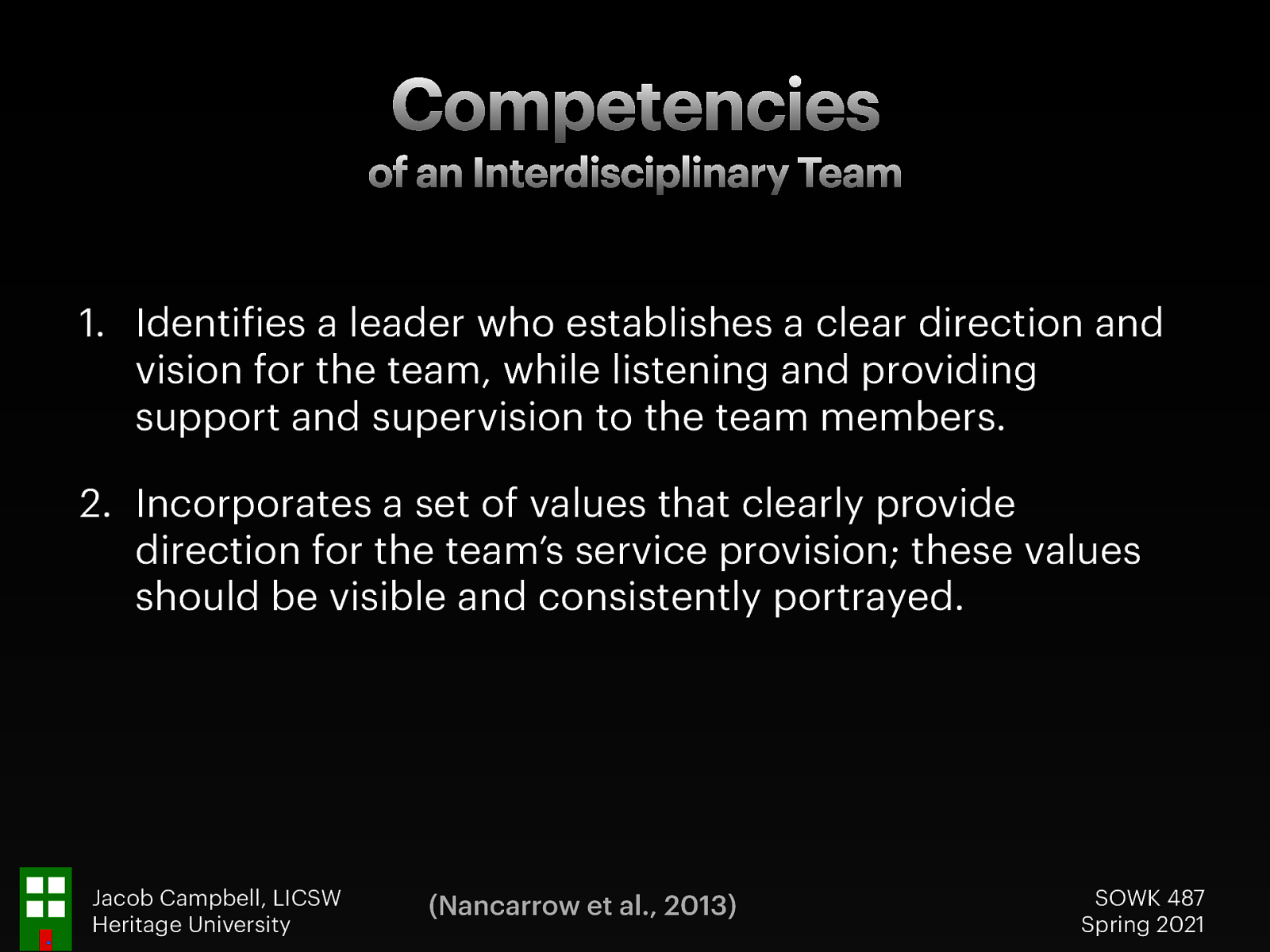
Competencies of an Interdisciplinary Team (1 of 5)
Taken from— Nancarrow, S., Booth, A., Ariss, S., Smith, T., Enderby, P., & Roots, A. (2013). Ten principles of good interdisciplinary team work. Human Resources for Health, 11(1), 19. http://doi.org/10.1186/1478-4491-11-19
[Whole Class Activity] Discuss each of the topics and what they might look like
- Identifies a leader who establishes a clear direction and vision for the team, while listening and providing support and supervision to the team members.
- Incorporates a set of values that clearly provide direction for the team’s service provision; these values should be visible and consistently portrayed.
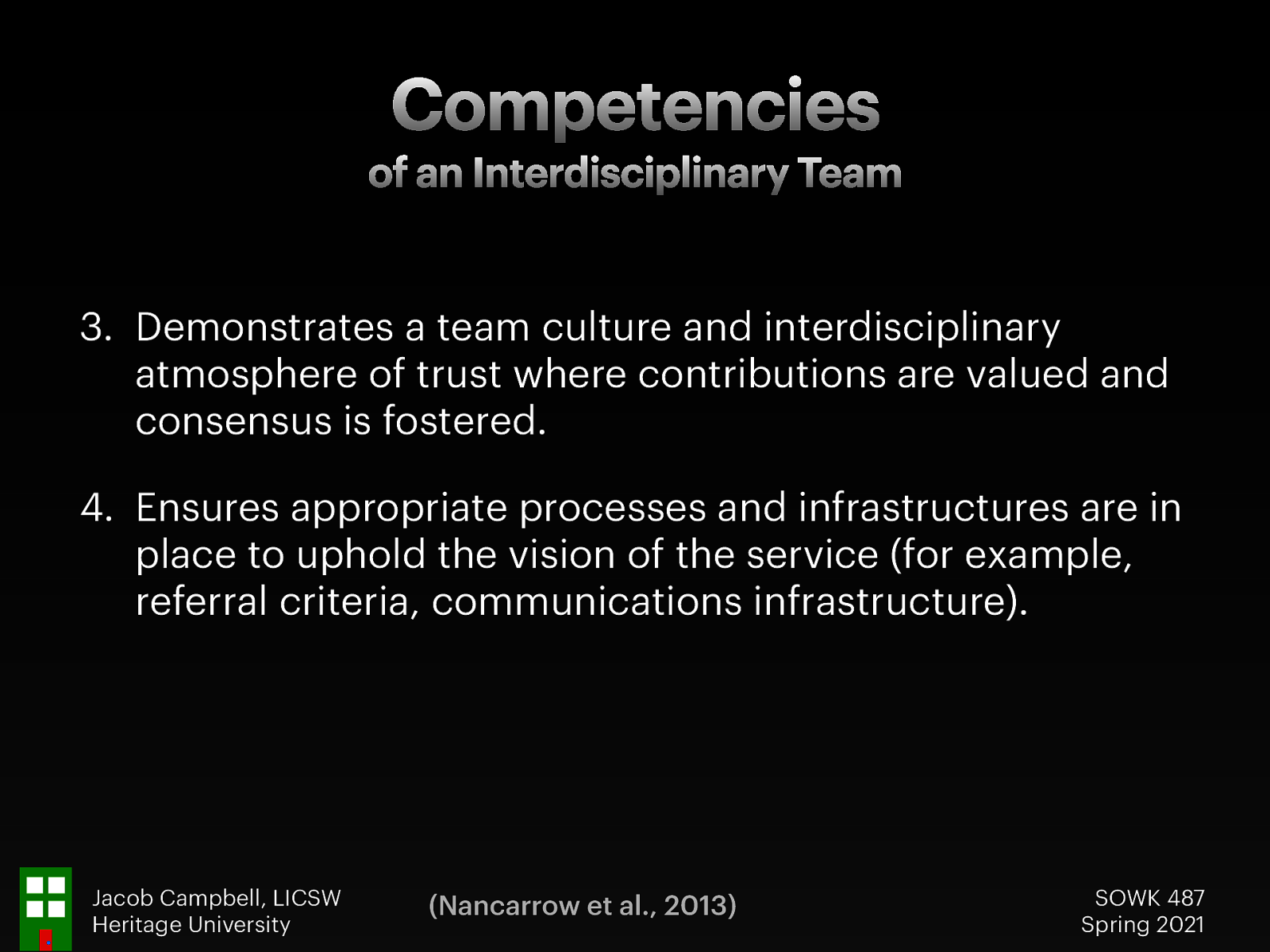
Competencies of an Interdisciplinary Team (2 of 5)
- Demonstrates a team culture and interdisciplinary atmosphere of trust where contributions are valued and consensus is fostered.
- Ensures appropriate processes and infrastructures are in place to uphold the vision of the service (for example, referral criteria, communications infrastructure).
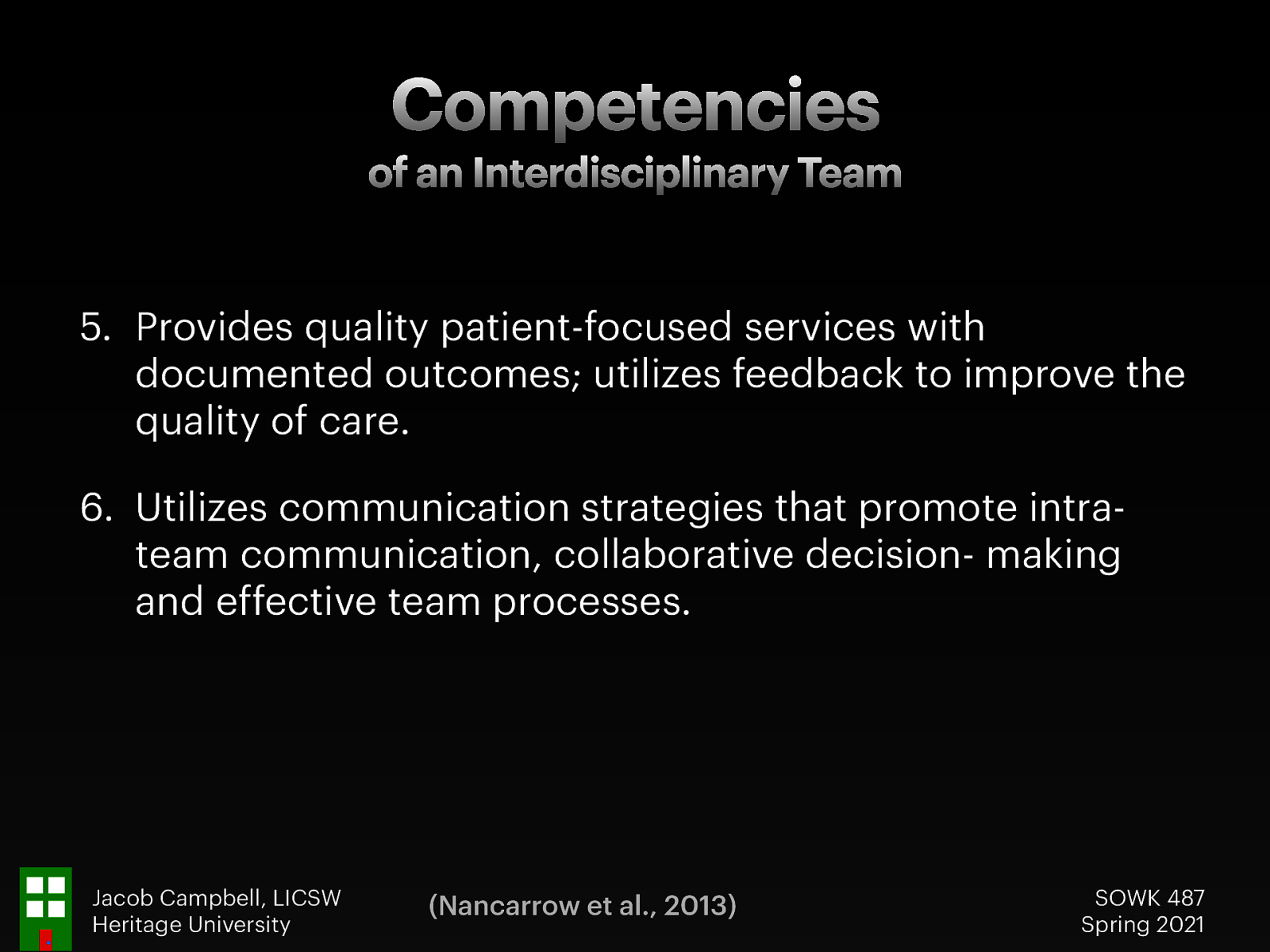
Competencies of an Interdisciplinary Team (3 of 5)
- Provides quality patient-focused services with documented outcomes; utilizes feedback to improve the quality of care.
- Utilizes communication strategies that promote intra-team communication, collaborative decision- making and effective team processes.
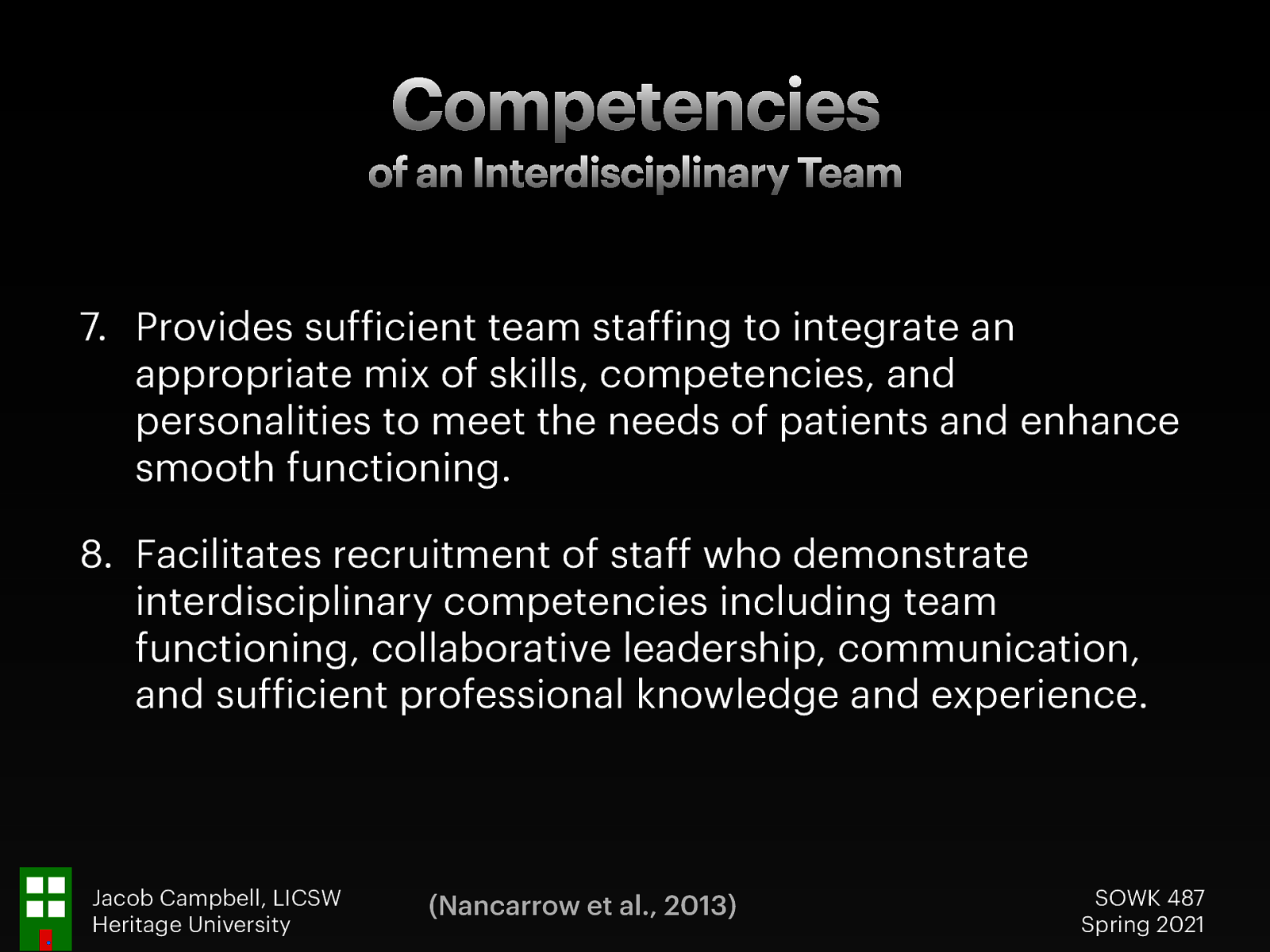
Competencies of an Interdisciplinary Team (4 of 5)
- Provides sufficient team staffing to integrate an appropriate mix of skills, competencies, and personalities to meet the needs of patients and enhance smooth functioning.
- Facilitates recruitment of staff who demonstrate interdisciplinary competencies including team functioning, collaborative leadership, communication, and sufficient professional knowledge and experience.
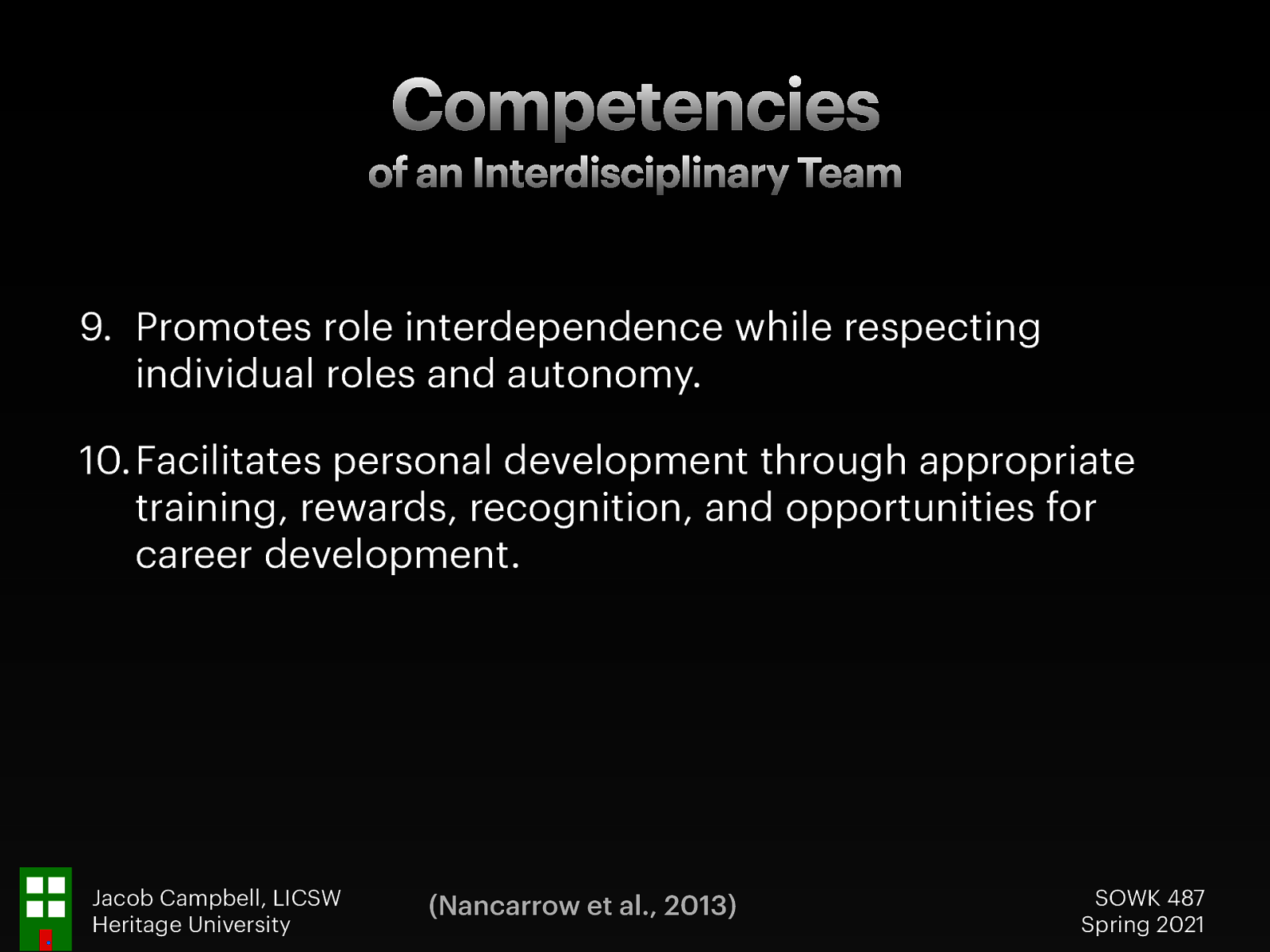
Competencies of an Interdisciplinary Team (5 of 5)
- Promotes role interdependence while respecting individual roles and autonomy. 10.Facilitates personal development through appropriate training, rewards, recognition, and opportunities for career development.
Week 15 continues on looking at task groups within a social work context. Bronstein and Abramson (2017) look into interdisciplinary teamwork. We will also supplement this discussion with Nancarrow et al. (2013) and discussion about the principles of good interdisciplinary teamwork. We also review what are some of the best practices that work for working groups, as described by Ephross et al. (2017).
The agenda for this week is as follows:
- Multidisciplinary, interdisciplinary, and transdisciplinary
- Characteristics of a team
- Being a good team member
- Competencies for interdisciplinary teamwork
Reference
Bronstein, L. R., & Abramson, J. S. (2017). Chapter 27 - Group process dynamics and skills in interdisciplinary teamwork. In C. D. Garvin, L. M. Gutierrez, & M. J. Galinsky Handbook of Social Work with Groups (pp. 491-509). The Guilford Press.
Ephross, P. H., Vassil, T. V., & Rose, S. R. (2017). Chapter 28 - Group work with working groups. In C. D. Garvin, L. M. Gutierrez, & M. J. Galinsky Handbook of Social Work with Groups (pp. 510-524). The Guilford Press.
Nancarrow, S., Booth, A., Ariss, S., Smith, T., Enderby, P., & Roots, A. (2013). Ten principles of good interdisciplinary team work. Human Resources for Health, 11(1), 19. https://doi.org/10.1186/1478-4491-11-19
